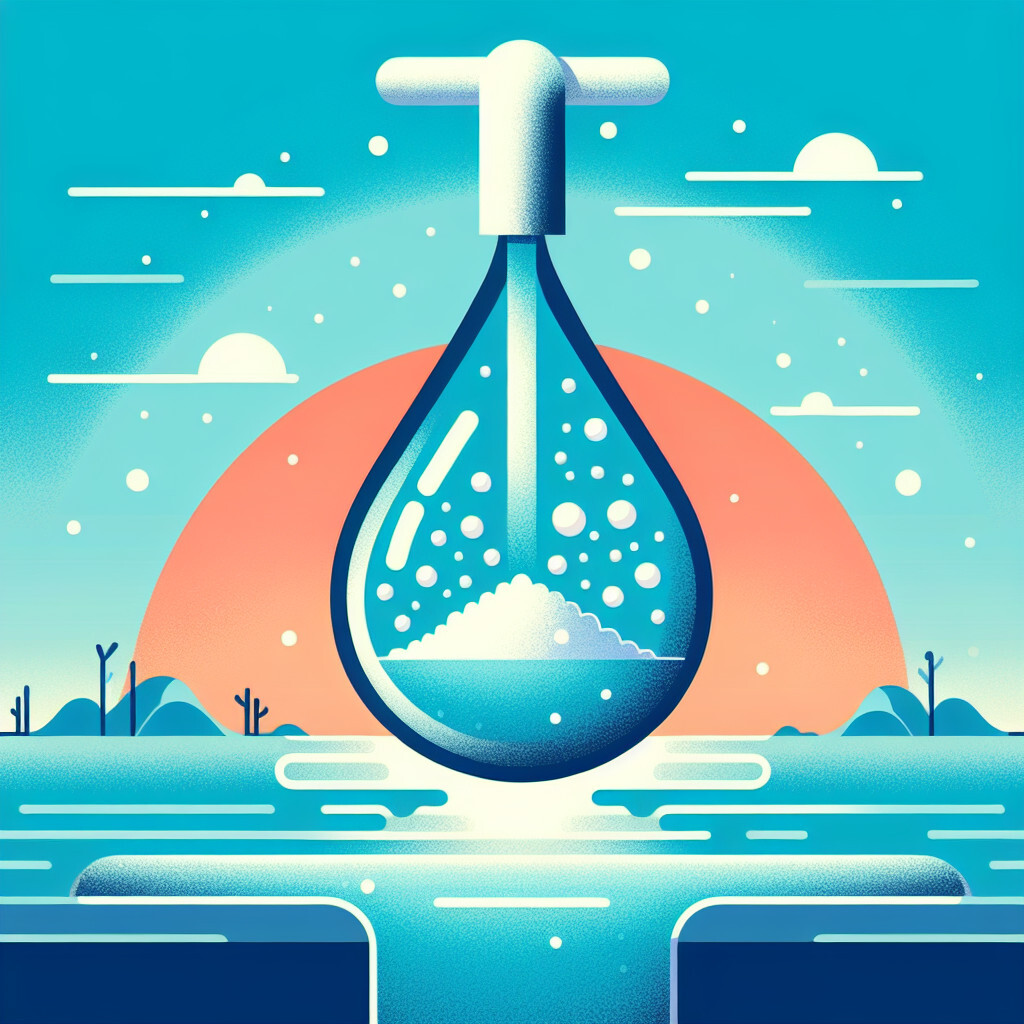-
Table of Contents
“Water: A Different Story in Every Country”
Introduction

Water, a fundamental resource for life and development, varies greatly in its availability, usage, and management across different countries. In some regions, such as the arid Middle East or drought-stricken parts of Africa, water scarcity is a significant issue, affecting both human health and economic growth. Conversely, in countries with abundant rainfall like Brazil or Indonesia, water is plentiful but may face issues related to pollution or inefficient infrastructure. Developed nations like the United States or Germany have advanced water management systems, but still grapple with challenges like aging infrastructure or climate change-induced water stress. Thus, the story of water is diverse and complex, reflecting the unique geographical, socio-economic, and political contexts of different countries.
Water Scarcity: A Comparative Study of Different Countries
Water, the most essential element for life, is becoming increasingly scarce in many parts of the world. This article aims to provide a comparative study of water scarcity in different countries, highlighting the severity of the issue and the need for immediate action.
Water scarcity is a global issue that affects every continent. According to the United Nations, more than two billion people live in countries experiencing high water stress. The situation is particularly dire in regions like Sub-Saharan Africa, the Middle East, and parts of Asia, where access to clean, safe drinking water is a daily struggle.
In Sub-Saharan Africa, water scarcity is a significant issue, with over 40% of the population lacking access to clean drinking water. The situation is exacerbated by factors such as rapid population growth, climate change, and inadequate infrastructure. For instance, in countries like Ethiopia and Somalia, recurring droughts have led to severe water shortages, affecting both human health and agricultural productivity.
In contrast, the Middle East, one of the most water-scarce regions in the world, faces a different set of challenges. Despite being home to only about 6% of the world’s population, the region contains less than 1% of the world’s renewable freshwater resources. Countries like Yemen and Jordan are particularly affected, with water scarcity being exacerbated by political instability, conflict, and rapid urbanization.
Meanwhile, in Asia, countries like India and China are grappling with the dual challenge of water scarcity and pollution. Rapid industrialization and urbanization have led to the overexploitation and contamination of water resources, affecting the availability of clean drinking water. In India, for example, it is estimated that 21% of the country’s diseases are related to unsafe water.
On the other hand, developed countries like the United States and Australia are not immune to water scarcity. In the United States, states like California and Arizona have experienced severe droughts in recent years, leading to water restrictions and increased competition for water resources. Similarly, in Australia, prolonged periods of drought have led to critical water shortages, particularly in rural and remote areas.
However, it’s important to note that water scarcity is not just about the physical availability of water. It’s also about the capacity to provide clean, safe drinking water and the efficient management of water resources. In this regard, countries like Singapore and Israel stand out. Despite their lack of natural water resources, these countries have successfully managed their water scarcity issues through innovative solutions like desalination, water recycling, and efficient water management practices.
In conclusion, water scarcity is a pressing issue that affects countries across the globe, regardless of their level of development. While the causes and impacts of water scarcity vary from region to region, the need for sustainable water management is universal. As the world’s population continues to grow and climate change intensifies, addressing water scarcity will become even more critical. It is, therefore, imperative for countries to invest in sustainable water management practices and technologies, promote water conservation, and strengthen international cooperation in addressing this global challenge.
The Role of Water in Cultural Practices Across Countries
Water, the most essential element of life, plays a significant role in the cultural practices of different countries around the globe. Its importance transcends the basic necessity of hydration and sanitation, extending into the realm of spiritual, religious, and social significance. This article aims to explore the diverse roles that water plays in various cultural practices across countries.
In India, water holds a profound spiritual and religious significance. The River Ganges, considered sacred by Hindus, is believed to purify the soul and cleanse sins. Pilgrims from all over the country travel to bathe in its waters, a ritual believed to bring salvation. Similarly, in the Buddhist tradition, water is used in a ceremony called ‘Water Pouring,’ symbolizing the transfer of merit to the departed. This ritual is a testament to the belief in the purifying and life-giving properties of water.
Moving to the African continent, water is deeply embedded in the cultural fabric. In many African cultures, water symbolizes life, purity, and fertility. For instance, in the Maasai community in Kenya and Tanzania, water is considered a blessing. During weddings, elders sprinkle water on the couple as a symbol of fertility and prosperity. In Egypt, the Nile River has been central to their civilization, providing sustenance and enabling agriculture, which led to the growth of the ancient Egyptian civilization.
In Japan, water is an integral part of Shinto, the indigenous faith of the Japanese people. The Shinto practice of Misogi involves purification through immersion in water. This ritual is believed to cleanse the body and spirit, promoting physical and spiritual health. Similarly, in the Japanese tea ceremony, water is not just a medium for brewing tea but is considered a symbol of purity and harmony.
In the Americas, Native American tribes hold water in high regard. For the Hopi tribe in Arizona, water is seen as the blood of Mother Earth and is treated with utmost respect. Water plays a central role in their ceremonies and dances, which are performed to bring rain and ensure a good harvest. In South America, the Incas worshipped water and built impressive structures like the Tipon water temple in Peru, dedicated to the water deity.
In Europe, water has been historically significant in various cultures. The ancient Romans built elaborate aqueducts to supply water to their cities, reflecting the importance of water in their society. In Celtic traditions, holy wells were considered sacred, and water from these wells was believed to have healing properties.
In the Middle East, water is a symbol of life and purity in Islam. The ritual of Wudu, or ablution, involves washing with water before prayers, emphasizing cleanliness and purity. The Zamzam well in Mecca is considered holy, and water from this well is believed to have healing properties.
In conclusion, water’s role in cultural practices across countries is as diverse as it is significant. It is not just a life-sustaining necessity but a symbol of life, purity, fertility, and prosperity. It is deeply woven into the fabric of various cultures, shaping rituals, ceremonies, and beliefs. The reverence for water across different cultures underscores its universal importance and the need for its conservation. As we continue to grapple with issues of water scarcity and pollution, it is crucial to remember the cultural significance of water and strive to protect this vital resource.
Water Management Strategies in Developed and Developing Countries
Water, the lifeblood of our planet, is a resource that is both abundant and scarce. Its management is a critical issue that countries around the world grapple with, and the strategies employed vary significantly between developed and developing nations. This article will explore the different water management strategies in these countries, highlighting the challenges and successes they encounter.
In developed countries, water management strategies are often sophisticated and multi-faceted, reflecting the complex needs of their societies. These nations typically have the financial resources and technological capabilities to implement advanced water management systems. For instance, they often employ strategies such as water recycling, desalination, and the construction of reservoirs and dams to ensure a steady supply of water. Additionally, they invest in infrastructure to treat wastewater, ensuring it is safe to return to the environment or reuse.
However, even in developed countries, water management is not without its challenges. Climate change, population growth, and urbanization are putting increasing pressure on water resources. As a result, these countries are continually seeking innovative solutions to conserve water and use it more efficiently. For instance, many are promoting water-saving appliances and fixtures, encouraging rainwater harvesting, and implementing policies to reduce water waste.
In contrast, developing countries often face a different set of challenges when it comes to water management. Many lack the financial resources and technical expertise to implement advanced water management systems. As a result, they often struggle with issues such as water scarcity, poor water quality, and inadequate sanitation.
In these countries, water management strategies often focus on improving access to clean water and sanitation facilities. This can involve drilling wells, building simple sanitation facilities, and educating communities about the importance of hygiene practices. Additionally, many developing countries are working to improve their water infrastructure, such as pipes and pumps, to reduce water loss and ensure a more reliable supply.
However, these efforts are often hampered by a lack of funding and technical expertise. Furthermore, issues such as political instability, corruption, and poor governance can also hinder progress. As a result, many people in developing countries still lack access to clean, safe water, and sanitation facilities.
Despite these challenges, there are also success stories. For instance, some developing countries have made significant strides in improving water management through community-led initiatives. These often involve local people in the planning and implementation of water projects, ensuring they are tailored to the community’s needs and sustainable in the long term.
In conclusion, water management is a complex issue that requires tailored strategies depending on a country’s level of development, resources, and specific challenges. Developed countries, with their advanced systems and technologies, face the task of ensuring sustainable water use in the face of growing demand and environmental changes. On the other hand, developing countries must overcome significant hurdles to provide their populations with access to clean water and sanitation. Despite the challenges, progress is being made, and the importance of effective water management is increasingly recognized worldwide.
Impact of Climate Change on Water Resources in Various Countries
Water, the lifeblood of our planet, is a resource that is both abundant and scarce. It covers about 70% of the Earth’s surface, yet only a small fraction of it is available for human use. The distribution and availability of water vary greatly from one country to another, and these disparities are further exacerbated by the impacts of climate change.
Climate change, a global phenomenon, has profound implications for water resources across the world. It alters the hydrological cycle, leading to changes in precipitation patterns, evaporation rates, and the frequency and intensity of extreme weather events. These changes, in turn, affect the quantity and quality of water available for human consumption, agriculture, and energy production.
In many parts of the world, climate change is leading to increased water scarcity. In the arid regions of Africa and the Middle East, for instance, rising temperatures and decreasing rainfall are exacerbating existing water shortages. These regions are experiencing longer and more severe droughts, leading to declines in agricultural productivity and increased food insecurity. Similarly, in Australia, prolonged periods of drought have led to severe water shortages, forcing the government to implement strict water rationing measures.
On the other hand, in some regions, climate change is leading to an overabundance of water. In South Asia, for instance, melting glaciers in the Himalayas are causing rivers to swell, leading to frequent and devastating floods. These floods not only cause widespread destruction but also contaminate freshwater sources, making them unfit for human consumption. Similarly, in the low-lying countries of the Pacific Islands, rising sea levels are leading to the intrusion of saltwater into freshwater aquifers, threatening the availability of potable water.
Moreover, climate change is also affecting water quality. Rising temperatures can increase the concentration of pollutants in water bodies, making them unsafe for human use. In addition, changes in precipitation patterns can lead to increased runoff, carrying pollutants and sediments into water bodies. This not only affects the quality of water but also harms aquatic ecosystems.
The impacts of climate change on water resources have significant implications for human health and livelihoods. Water scarcity can lead to food and energy shortages, while water abundance can lead to flooding and loss of property. Moreover, poor water quality can lead to the spread of waterborne diseases. Therefore, addressing the impacts of climate change on water resources is crucial for ensuring human well-being and sustainable development.
Countries around the world are taking various measures to mitigate the impacts of climate change on water resources. These include improving water management practices, investing in water-efficient technologies, and promoting water conservation. However, these efforts are often hampered by a lack of resources and technical capacity, particularly in developing countries.
In conclusion, climate change poses a significant threat to water resources in various countries. It is leading to increased water scarcity in some regions and an overabundance of water in others, while also affecting water quality. Addressing these challenges requires concerted global efforts, including improved water management, investment in water-efficient technologies, and promotion of water conservation. As the impacts of climate change continue to intensify, ensuring the sustainable management of water resources will become increasingly important for the survival and prosperity of humanity.
Q&A
1. Question: Which country has the cleanest water in the world?
Answer: According to various reports, Iceland is considered to have the cleanest water in the world.
2. Question: Which country is facing the most severe water crisis?
Answer: As per the World Resources Institute, Qatar faces the most severe water crisis.
3. Question: What country uses the most water per capita?
Answer: The United States has the highest water footprint, using the most water per capita.
4. Question: Which country has the largest freshwater reserve?
Answer: Brazil has the largest freshwater reserve in the world.
Conclusion
In conclusion, the availability and quality of water varies significantly across different countries. Developed nations typically have easy access to clean, safe drinking water, while many developing countries struggle with water scarcity and pollution. This disparity often leads to health issues and hinders socio-economic development in water-deprived regions. Therefore, global efforts are needed to improve water management and infrastructure, and to ensure equitable access to this vital resource.






